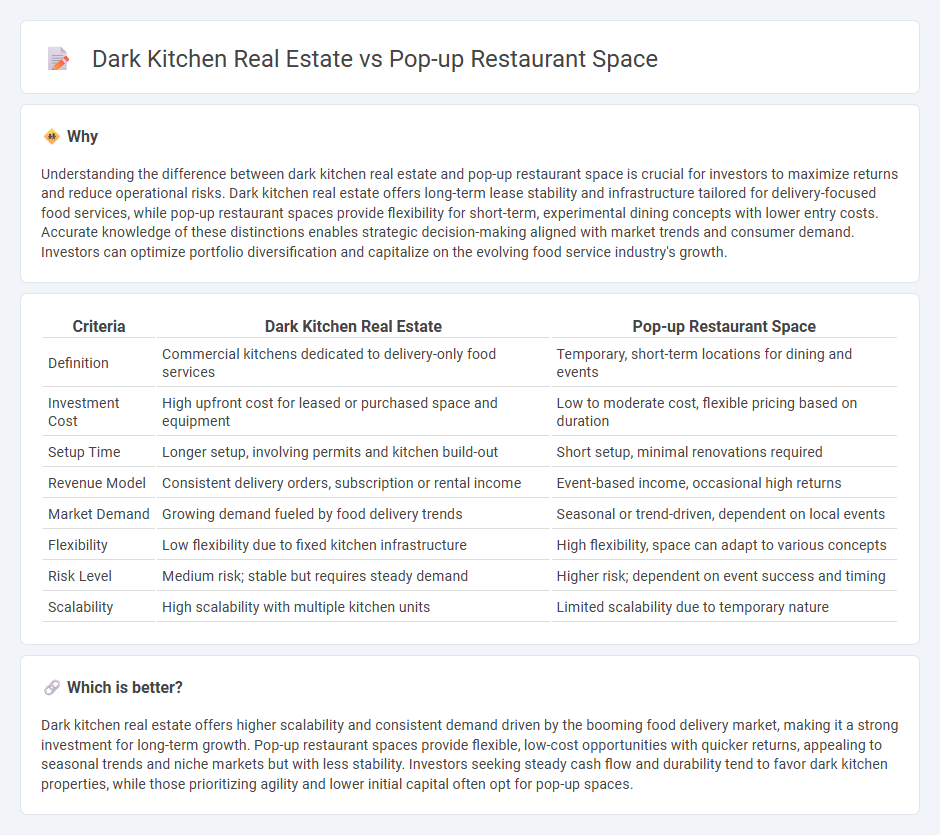
Dark kitchen real estate offers scalable, low-overhead investment opportunities by eliminating the need for traditional dining areas, maximizing kitchen efficiency in strategically located urban settings. Conversely, pop-up restaurant spaces provide flexible, short-term leasing options that capitalize on emerging market trends and customer foot traffic without long-term commitments. Explore the unique benefits and risks of each investment model to determine the best fit for your portfolio.
Why it is important
Understanding the difference between dark kitchen real estate and pop-up restaurant space is crucial for investors to maximize returns and reduce operational risks. Dark kitchen real estate offers long-term lease stability and infrastructure tailored for delivery-focused food services, while pop-up restaurant spaces provide flexibility for short-term, experimental dining concepts with lower entry costs. Accurate knowledge of these distinctions enables strategic decision-making aligned with market trends and consumer demand. Investors can optimize portfolio diversification and capitalize on the evolving food service industry's growth.
Comparison Table
| Criteria | Dark Kitchen Real Estate | Pop-up Restaurant Space |
|---|---|---|
| Definition | Commercial kitchens dedicated to delivery-only food services | Temporary, short-term locations for dining and events |
| Investment Cost | High upfront cost for leased or purchased space and equipment | Low to moderate cost, flexible pricing based on duration |
| Setup Time | Longer setup, involving permits and kitchen build-out | Short setup, minimal renovations required |
| Revenue Model | Consistent delivery orders, subscription or rental income | Event-based income, occasional high returns |
| Market Demand | Growing demand fueled by food delivery trends | Seasonal or trend-driven, dependent on local events |
| Flexibility | Low flexibility due to fixed kitchen infrastructure | High flexibility, space can adapt to various concepts |
| Risk Level | Medium risk; stable but requires steady demand | Higher risk; dependent on event success and timing |
| Scalability | High scalability with multiple kitchen units | Limited scalability due to temporary nature |
Which is better?
Dark kitchen real estate offers higher scalability and consistent demand driven by the booming food delivery market, making it a strong investment for long-term growth. Pop-up restaurant spaces provide flexible, low-cost opportunities with quicker returns, appealing to seasonal trends and niche markets but with less stability. Investors seeking steady cash flow and durability tend to favor dark kitchen properties, while those prioritizing agility and lower initial capital often opt for pop-up spaces.
Connection
Investment in dark kitchen real estate capitalizes on the rising demand for food delivery services, making these properties highly attractive for pop-up restaurant spaces seeking low-cost, flexible operations. Dark kitchens provide optimized infrastructure and strategic locations that allow pop-up restaurants to test markets and expand quickly without traditional dine-in overhead. The synergy between dark kitchen real estate and pop-up concepts accelerates growth in the food delivery sector while maximizing returns for investors focused on commercial real estate and hospitality ventures.
Key Terms
Lease Flexibility
Pop-up restaurant spaces offer short-term lease flexibility ideal for testing new markets and concepts quickly, while dark kitchen real estate typically requires longer commitments tailored for high-volume delivery operations. Flexible leasing in pop-up venues reduces upfront costs and risk, making them attractive for startups and seasonal menus, whereas dark kitchens provide optimized layouts but less adaptability in lease terms. Explore deeper insights on how lease flexibility impacts operational strategies in evolving foodservice landscapes.
Location Visibility
Pop-up restaurant spaces capitalize on prime, high-visibility locations to attract walk-in customers and create buzz through strategic street presence. Dark kitchens prioritize cost-efficient real estate in less visible areas, focusing on logistics and delivery optimization rather than foot traffic. Explore our detailed analysis to understand how location visibility impacts business models in the food service industry.
Operational Overheads
Pop-up restaurant spaces typically incur higher operational overheads due to short-term leases, dynamic staffing needs, and the costs of event-specific marketing, whereas dark kitchens benefit from streamlined operations focused solely on food preparation with flexible, lower-cost rental spaces. Dark kitchens reduce expenses linked to front-of-house services, enabling more efficient use of real estate while avoiding the fluctuating costs associated with physical dining environments. Explore the comparative financial impacts and strategic benefits of pop-up spaces versus dark kitchens to optimize your food business operations.
Source and External Links
Popup Chicago - Event Venue Rental - This versatile, ground-level venue near I-94 features stunning hardwood floors, a fully-equipped kitchen, and flexible space for up to 35 standing guests (25 seated), with options for external catering, parking, and BYO alcohol, catering to pop-ups, exhibits, product launches, and more.
36 Best Pop Up Restaurant Venues for Rent in Chicago, IL - Peerspace lists dozens of curated pop-up restaurant venues across Chicago, with average rental rates around $121 per hour and a variety of neighborhood options--ranging from small, affordable spaces to larger, premium spots.
Pop-Up Frequently Asked Questions - Chicago's official guidelines clarify that licensed restaurants and shared kitchen users can operate pop-ups in approved locations with proper licensing and equipment, subject to local health and safety regulations.
 dowidth.com
dowidth.com